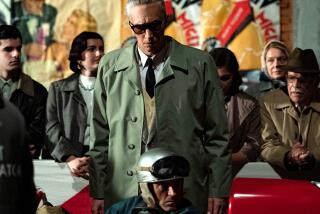Fangio, Five-Time World Champion Formula One Race Driver, Dies at 84
- Share via
Juan Manuel Fangio, considered in most racing circles as the greatest race driver who ever lived, died Monday in his native Argentina of complications of pneumonia and kidney failure. He was 84.
During seven remarkable seasons in Formula One Grand Prix racing between 1950 and 1957--he did not drive Grand Prix events in ‘52--Fangio won a record five world championships, four in a row, in four different makes of car. And all that occurred after he had turned 40.
No one else has won more than four world titles. In 51 world-championship races, Fangio won 24 and started on the pole in 29.
“The Maestro,” as he was known for his almost mystical qualities between the wheel of racing machines, never raced in a U.S. Grand Prix, although he made one fruitless visit to Indianapolis in 1958 when the Indy 500 was part of the Formula One schedule, and appeared in an exhibition before the first Long Beach Grand Prix in 1976.
Dan Gurney did not race against him, but was there in a preliminary race when Fangio drove his final Grand Prix, July 6, 1958, at Reims, France.
“He was a Latin American gentleman who carried himself with great dignity, both on the race track and off,” Gurney said Monday. “He spoke only Spanish and Italian, but when he walked into a room . . . he had an aura about him that was amazing.”
Gurney had an occasion to drive against him in the Long Beach exhibition, but even then, years after both had retired, Gurney admits he was in awe of being on the same track as the Maestro.
“He was in a ’55 Mercedes-Benz and I was in a ’59 BRM, a much faster car, but when we were on the track I was almost embarrassed to pass him,” Gurney recalled. “I thought maybe I shouldn’t do it, but I finally did.
“When we came in, he smiled at me and said, ‘What’s the idea of picking on an old guy like that?’ ” Fangio was 65 at the time.
Those who were at Long Beach will never forget the sight of Fangio, sitting in the upright posture of the front-engine racing car, wearing his brown half-helmet with its canvas chin strap, a white short-sleeve shirt and blue slacks.
There were no seat belts, no fire suits and no shoulder harness in his era, and he wore none in the exhibition.
Gurney later hired Fangio’s nephew, Juan Manuel II, to drive a Toyota in the International Motor Sports Assn. GTP class. The younger Fangio won two championships, but his famous uncle never saw him race in person.
“I always felt it a distraction to have family around when I raced,” the older Fangio said a few years ago when he came to the United States for the Historic Monterey races at Laguna Seca. “I keep in touch with Juan on my satellite TV and I talk with him by telephone, but I do not want to be a handicap by going to his races.”
Fangio, the son of Italian immigrants, was born June 24, 1911, in Balcarce, a small farming town in Argentina. He quit school at 11 to become an apprentice mechanic and drove in his first race in 1934, in a borrowed Model A Ford.
Years later, he would say that he learned to race by “driving Fords and Chevies on unpaved roads in Argentina and [elsewhere in] South America.”
Fangio attracted attention in 1940, when he won the 5,900-mile Gran Premio del Norte from Buenos Aires to Lima, Peru and back--twice crossing the Andes. Shortly after that, however, racing was halted by World War II, so Fangio did not have an opportunity to race in Europe until he was 38.
Once there, he made the most of it. After racing his own Maserati for a year, he signed to drive an Alfa Romeo in the 1950 Grand Prix season, finishing second to Giuseppe Farina in his first year.
Fangio remained with Alfa in 1951 and won his first championship. When Alfa Romeo dropped from the series in 1952, Fangio was left without a ride. In 1953 he returned with Maserati and although he won only one GP he finished second to Alberto Ascari.
Then he began his remarkable streak of four championships, first with a Maserati and Mercedes-Benz in 1954, then with Mercedes in 1955 before the German team dropped out of racing. This time he was not without a ride for long, signing with Ferrari and winning the 1956 title, which he repeated the following year with Maserati again.
Former world champion John Surtees, in his “Pirelli Album of Motor Racing Heroes,” says of Fangio: ‘As a driver, [he] had exceptional skills, a high degree of confidence, great competitive intelligence, and an astonishing sense of balance--all of which brought consistent success.”
Shortly before he retired, Fangio went to Indianapolis for the 500 but after testing briefly, elected not to race. Two months later, he retired.
“My best friends died in stupid accidents and I didn’t want to go on,” Fangio said at the time. “I raced 10 years professionally and 30 drivers died racing during that time. I felt it was time to move on.”
Fangio owned numerous car dealerships in Argentina and became president of Mercedes-Benz, Argentina. At the time of his death, he remained honorary president.
A wake was held Monday at the Argentina Automobile Club in Buenos Aires, and the funeral will be held today in his hometown of Balcarce.
More to Read
Go beyond the scoreboard
Get the latest on L.A.'s teams in the daily Sports Report newsletter.
You may occasionally receive promotional content from the Los Angeles Times.










